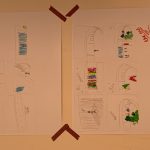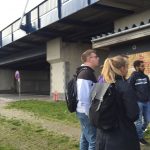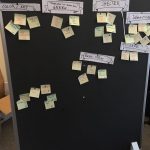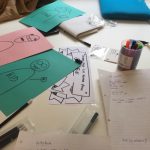Nørresundby possesses a lot of areas with a great historically and symbolic meaning. However, in pace with the comprehensive waterfront development, it has been apparent that space under the bridge, despite of its central location, is a “non-space” without a program or natural flow of citizens. Furthermore, the place is considered unsafe and worn down. In connection to this, our group has gone through the proposed process of U-CrAc to build proposals on how the municipality can get more citizens to make active use of the area under the bridge in Nørresundby.
Members of the team:
- Elsa Jarrige (Entrepreneurial Engineering)
- Jannik Strohbeck (Entrepreneurial Engineering)
- Emilie Herskind (Interactive Digital Media)
- Morten Lykke Nielsen Jørgensen (Experience Design)
- Maja Frederiksen (Interactive Digital Media)
- Mija Draganic (Experience Design)
Concept video
Have you ever dreamt to interact more with nature while being in the heart of the city? Aalborg commune enables this opportunity for you! With the new Chasing Waterfalls concept, the dark, dirty and boring no-go area under the Limfjords bridge on the Nørresundby side becomes a place to smile and feel good.
Come see the beauty through the charming Nørresundby’s waterfall, your new spot for selfies! Don’t be scared to go through the waterfall as it is an interactive waterfall. Sensors will detect you and stop the water as you pass and interactive stairs make the way to the water front from the bridge way shorter and funnier! During the night, light in different colors are projected on the waterfall which makes it a delightfull place to walk to.
The Design Process
Day 1… On the first day we were divided in groups consisting of two students from each of the master’s degrees; Entrepreneurial Engineering, Interactive Digital Media and Experience Design. We were handed our case description and started brainstorming and preparing questions for our case partner, Aalborg Municipality. Talking to the two representatives from Aalborg Municipality gave us a short insight into the different challenges they are facing regarding the area under the bridge on the Nørresundby side.
Day 2… On day two we met with our case partner under the bridge to see the location. We made sure to ask further questions and to record videos and take photos while being there to use for documentation. Shortly after the guided tour with the case partner, our group sat down to discuss how we wanted to do our fieldwork research. We made an interview guide in order to make sure we were all having the same approach so that our findings were easier to compare.
Day 3… We devoted this day to do fieldwork research and divided ourselves into 3 groups of 2 to cover more ground. We interviewed people respectively under the bridge on the Nørresundby side, on the bridge and on the harbor front of Aalborg. Doing this we wanted to find out about people’s opinions on the bridge, their opinions on the atmosphere under the bridge on both sides and what peoples favorite places in Aalborg are. It helped to get inspiration on what draws people to certain places. In addition, we observed the flow of traffic in the area and found out that there is actually a constant flow of people – people just don’t stop to spend time under the bridge. With these interviews and observations, we will later on be formulating ideas as to how the non-space under the bridge can be used and further developed. We then met in the afternoon to compare and discuss our findings.
Day 4… We tried the sandboxing method in class as an abstract representation from our observations. We videotaped our discussion while moving the different objects around and used this method for idea generation. Afterwards we went to StartUpWorks to put our findings on a board to try to make sense of all the information gathered. For this, we used affinity diagraming to map out what is at stake. We highlighted the problem areas based on our interviews/observations and identified our possible target groups.
Day 5… From the problem areas previously identified, we worked on finding the core qualities for the different problems to be solved. First, we brainstormed on the qualities and then tried organizing it into priority layers. This led us to the following four innovation tracks: games/play, shelter, art/installation and park/garden. The Innovation tracks helped us find potential directions for our project. We agreed on dividing the work for the weekend, e.g. to prepare mood boards to develop the tracks with our case partner on day 6.
Day 6… This day was devoted for the second meeting with the case partner. We met in the morning to agree on how we will present our innovation tracks and mood boards in order to generate a fluid and efficient conversation with the case partner, and to agree on a contract. Our case partner seemed to like our ideas within the four different innovation tracks, and they suggested we should try to narrow it down by settle with an idea/few ideas that combine some of the innovation tracks in order to solve some of the main problems with the area.
Day 7… We were shortly intruduced to different sketching methods and we spend time finding a concept. Our final concept is described above. We used the stand scan method to develop our concept.
Day 8… We split up; some group members went to the site for more footage while others did green screen. We discussed the content of the final video and storyboards for the video was made. We started skething on the video, and searched for sounds and additional footage.
Day 9… We divided the work between us, respectively working on a stop motion video, the final video, the banner etc. Some group members worked on the introduction of the final video while others worked on making a model of the bridge to showcase the concept in the final video.
Day 10…
Sketches of the concept
This video illustrates the main problems we discovered when doing field research: the people interviewed find the area dark at night, boring/concrete, dirty and that the weather condition is quite windy. People passed by but wouldn’t stop to hang out.
This video illustrates in stop motion one, idea we had thought out the week about turning the no-go area under the Nørresundby side of the bridge ,into a perspective art where people can stand in different places to look at cool anamorphic art.
In this video we tried out the stand scan method. We came up with ideas and developed on different ideas by using this method. We decided to go with the chasing waterfalls idea because it had the potential to solve most of the main problems with the area and it made it possible for us to combine different innovation tracks.
This video showcase one out of many ideas we had within our four innovation tracks. What draws people to certain places? Cute drogs! However, we mainly used this video to practise video editing and Premiere Pro before jumping into making the final concept video.






